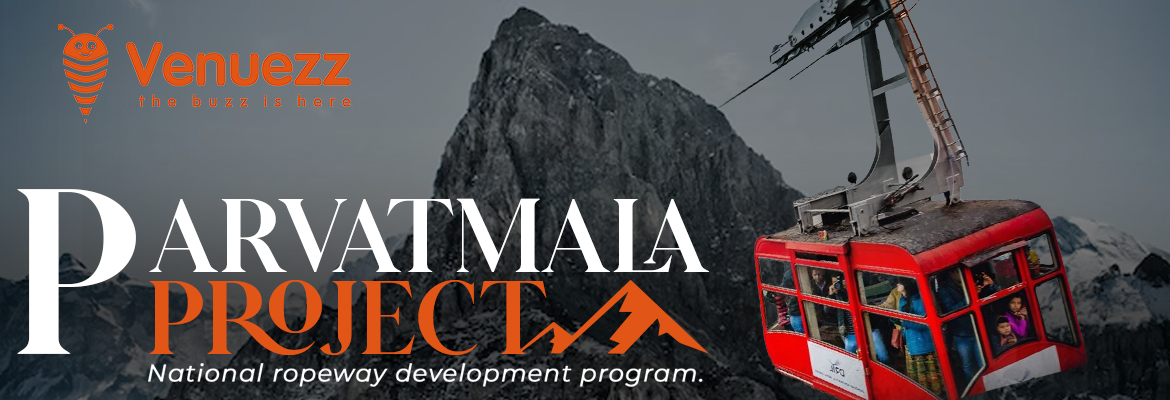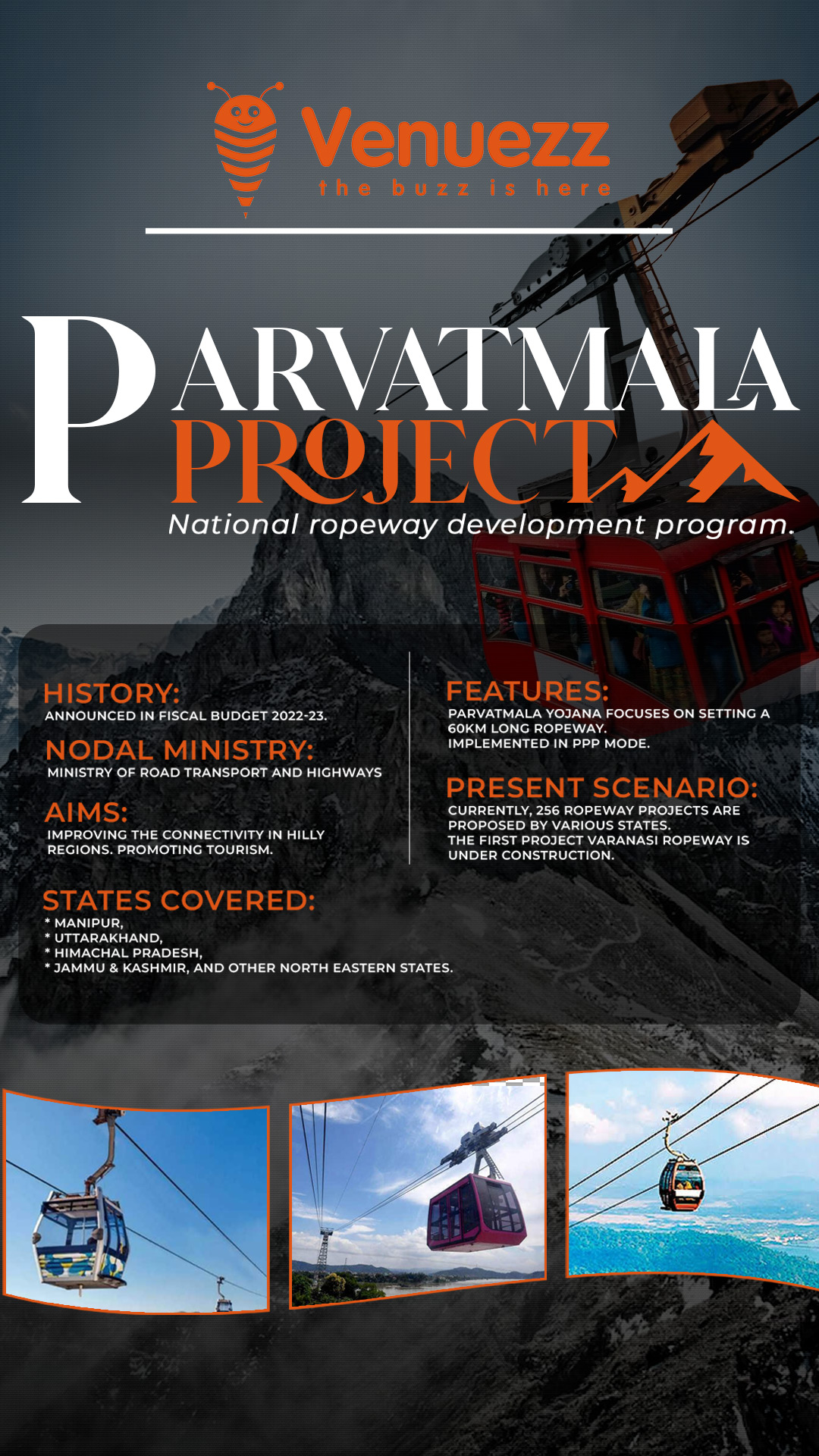

Home > Parvatmala: All about India's national ropeway development programme
- VBee
- January 28, 2023
- 12:20 pm
With its literal meaning, the garland of mountains, Parvatmala Yojana or Parvatmala project is a union government project that is supposed to ease the living and connectivity among the people living in the mountains. Recently, every news platform has covered this topic. And to make every single fact about Parvatmala accessible to our users, Venuezz has compiled a blog. Based on thorough research and reliable sources, this Blog provides information about Parvatmala Project: India’s national ropeway development programme.
History of Parvatmala Yojana
Finance Minister Shri Nirmala Sitharaman introduced Parvatmala Project, or the national ropeway development programme, in the Union Budget 2022-23. The project aims to take care of connectivity and development in the country, focusing on mountain or hilly regions.
Aim of the national ropeway development programme
The project aims at:
- Enhancing connectivity in hilly regions
- Enabling convenient and safe mobility for tourists and commuters in rugged hilly terrains.
- Promoting tourism in the mountainous areas of India.
States to be benefitted
The government of India has announced the Parvatmala Yojana to benefit all the mountainous and hilly regions of India. It was stated to start the project with eight ropeways covering an area of 60 km in 2022-23. Initially, the scheme will benefit states including Manipur, Uttarakhand, Himachal Pradesh, Jammu & Kashmir, and other North Eastern states.
Nodal Ministry
The Ministry of Road Transport and Highways, or MORTH, is the nodal ministry responsible for the development and progress of ropeways under the Parvatmala scheme. So far, this ministry is taking care of developing highways and the road transport system across India. But with amendments in the Government of India (Allocation of Business) Rules 1961 in 2021, MORTH is made accountable for the construction, research, policy, and development of ropeway and alternative mobility solutions technology.
Mode of implementation of the Parvatmala Scheme 2022-23
Parvatmala Yojana is introduced to be implemented through the PPP mode. PPP or Public-private partnership is a mode of implementing infrastructure projects in which the private sector is involved in the financing, design, construction, operation, and maintenance of a project. Under this mode, the government partners with private companies to deliver public infrastructure and services. PPPs can bring private-sector financing, which can help reduce the burden on government budgets and allow for more extensive and ambitious projects.
Also Read: Vishwas Swaroopam – The Tallest Statue Of Lord Shiva


Why is ropeway transportation economical in the country?
You might be wondering why GoI has chosen ropeways as the primary means in the Parvatmala project. Here are the reasons why ropeway. Ropeways, also known as aerial tramways or cable cars, can be an essential means of transportation and tourism for a company or community in hilly or mountainous regions. They can offer many economic benefits, such as:
- Transportation: Ropeways can provide a reliable and efficient means of transportation for people and goods in areas that are difficult to access by road. This can help to improve the local economy by making it easier for people to travel to work, shop, and access services.
- Tourism: Ropeways can be a major tourist attraction, providing visitors with stunning views and a unique transportation experience. It can lead to increased tourism revenue for the local community.
- Job creation: Ropeway construction and operation can create jobs for local residents, which can help to boost the local economy.
- Access to natural resources: Ropeways can be used to transport goods and materials in and out of remote areas. This can help to increase access to natural resources and improve economic development.
- Reducing pollution: Ropeway systems are relatively eco-friendly, they don’t emit any pollutants, and they can help to reduce the number of vehicles on the road, which can lead to decreased air and noise pollution.
- Cost-effective: Ropeways can be a cost-effective alternative to building roads or railways in hilly or mountainous regions, as the construction costs are relatively lower.
Overall, ropeways can offer a range of economic benefits for a company or community and can play an essential role in supporting sustainable development in hilly and mountainous areas.
(Also click here to know about the Vande Bharat Express, India.)
Current status of Parvatmala Yojana, 2022-23
Aiming for connectivity in the hilly region, Parvatmala can be a significant step from the Indian Government. On 8 November 2022, the Union Minister of Road Transport and Highways, Nitin Gadkari, informed that various states had proposed 256 ropeway projects for consideration under Parvatmala Project.
Besides, Varanasi’s ropeway project is the first step under the scheme. Also, the MORTH has signed an MoU with Uttarakhand Tourism Development Board (UTDB) , the tourism department of Uttarakhand to develop a ropeway in the state. Apart from the 3.85 km Varanasi Urban Ropeway, other potential names are:
- Kedarnath
- Ujjain
- Shivkhori
- Bijli Mahadev
- Hemkund Sahib
What is the significance of Parvatmala, the national ropeways development programme?
The Parvatmala Ropeway Project is a perfect blend of modernization and conservation. Here is the list of benefits of the Parvatmala project:
Ideal for rugged and sensitive terrain
The Parvatmala Project, being a ropeway project, is well suited for complex and sensitive terrain, as it does not require the construction of roads or rail infrastructure. Instead, it uses aerial cable cars to transport people and goods, which can be more easily installed in hilly or mountainous regions. It will improve the mobility of locals, farmers and traders, helping them to cross rivers, ravines, and other obstacles.
Low footprint
Additionally, using a ropeway eliminates the need for cutting down trees, leveling the terrain, and other land excavations, which can hurt the environment. Ropeways are also relatively less disruptive to the natural environment as they have a minimal physical footprint and can help to preserve the natural beauty of the region. In fact, if conducted with regulations, the project might help India fulfill the Paris Agreement and be a global climate leader.
Economy
Moreover, the ropeway can provide access to remote or hard-to-reach areas, which can help to promote tourism and support local economies. This can be particularly beneficial for people living in rugged and sensitive terrain, as it can help to improve their livelihoods and provide them with greater access to markets and services.
Can be completed effectively
Since the Parvatmala Project is designed and implemented using a Public-Private Partnership (PPP) mode, which can bring private-sector financing and expertise to ensure that the project is completed efficiently and effectively.
What are the challenges associated with the Parvatmala Ropeway Scheme?
The Parvatmala Ropeway Scheme, like any transportation infrastructure project, can be associated with several challenges. We have listed some of the potential difficulties along with their solutions that may arise:
Funding
Obtaining funding for the project can be difficult, especially if the project is large and complex. The project may require a significant investment from the government, the private sector, or a combination of both.
Environmental impact
Though in a minimum amount, building a ropeway system in a sensitive and challenging terrain may have adverse environmental effects such as deforestation, soil erosion, and disturbance to wildlife. Conducting thorough environmental impact assessments and taking appropriate measures to minimize any negative impact is essential.
Planning and design
Planning and designing a ropeway system in rugged terrain can be challenging and require specialized expertise. Careful attention should be paid to terrain, weather conditions, and safety requirements.
Also Read: Everything You Need To Know About Vande Bharat Express
Construction and maintenance
Building a ropeway system in rugged terrain can be difficult and time-consuming. It requires specialized equipment and skilled labor and may need to be done in stages. Maintenance of the ropeway system can also be complicated and costly, especially in remote and hard-to-reach areas.
Public acceptance
The Parvatmala Ropeway Scheme may face resistance from local tribal communities and other stakeholders if they do not fully understand the project’s benefits or if it is perceived as a threat to their livelihoods or way of life. It is vital to engage with local communities and other stakeholders early on in the project to build support and address any concerns.
Risk of accidents and malfunctions
Ropeways are mechanical systems subject to the risk of accidents and malfunctions. It is crucial to ensure that the system is designed and operated safely and reliably.
Simply put, careful planning, proper execution, and adequate management can minimize these challenges and ensure that the Parvatmala Ropeway Scheme is successful.
Do you know: One such existing ropeway is situated at Vaishno Devi, Katra, connecting the stiff elevation between Bhawan and Bhairon Baba.
Venuezz is a team of writers, photographers, digital marketers, illustrators, and social media experts who help companies tell their stories to be remembered for a long time. We assist your hospitality brand with our unique services and update our readers about current events in the field. For more updates, connect with us on social media.
